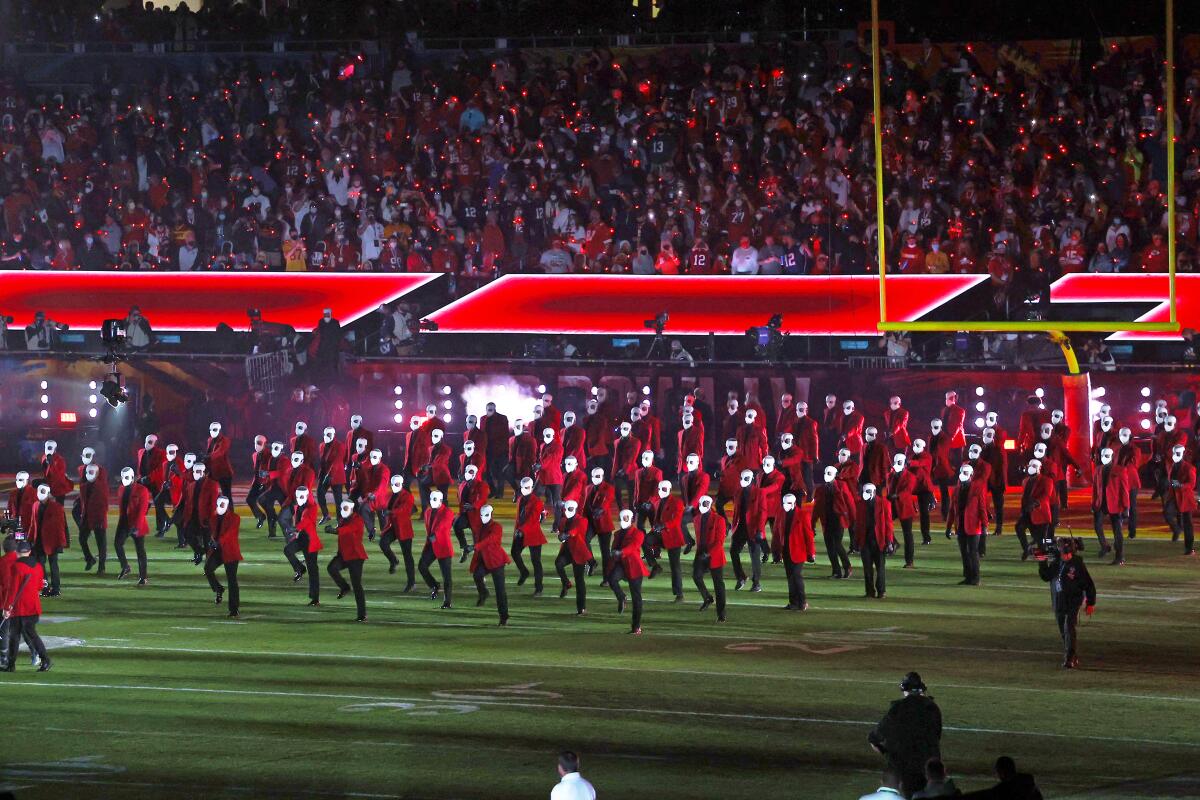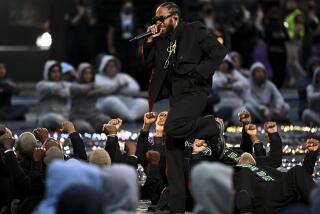Super Bowl halftime dancers’ $15-an-hour contract is ‘a disappointment,’ advocates say

- Share via
Four hundred volunteers working for up to 72 hours as “field cast participants” during this weekend’s Super Bowl LVI halftime show will be paid $15 per hour, according to a deal memorandum obtained Sunday by The Times. Treatment of these volunteers — who include aspiring dancers, actors, singers and musicians recruited from local drill teams as well as theatrical, community and athletic groups — emerged as a flashpoint in the dance community last month after dance artist and activist Taja Riley posted about the dancers’ lack of payment on her Instagram page.
Riley noted that a call had gone out through prominent dance agency Bloc LA, seeking volunteers to participate as part of the field cast, which generally appears— moving and grooving — in front of the stage while the musical talent performs alongside a cast of paid dancers. Halftime choreographer Fatima Robinson told The Times that the call went out as such because she is a Bloc client; the agency wanted to find out if other clients knew people who would be interested in volunteering.
“We’re not asking dancers to work as dancers for free,” Robinson told The Times. “What was asked is, ‘Would anyone like to volunteer for the field cast?’”
Robinson and the halftime show’s executive producer, Roc Nation, made it clear that they felt there was a distinct difference between the 115 paid dancers onstage and the volunteers on the field.
“The professional dancers are completely separate from the volunteer-based, non-choreographed field cast,” Jana Fleishman, executive vice president of strategy and communications for Roc Nation, wrote in a statement. “As in years past, it is completely up to the volunteer candidates to participate. Volunteers are not asked to learn choreography.”
Reports soon emerged that unpaid dancers worked side by side with paid dancers in last year’s Super Bowl halftime show featuring the Weeknd. And in late January, SAG-AFTRA issued a statement saying that the union and the producers of the Super Bowl Halftime Show “have met and had an open and frank discussion, and have agreed that no professional dancers will be asked to work for free as part of the halftime show. SAG-AFTRA will be advising our professional dancer members that they should not be rehearsing or working on the Super Bowl halftime show without compensation.”
All the while, Riley continued to advocate for payment — saying that absolutely no one — professional dancer or not — should be asked to volunteer for one of the year’s biggest money-making televised sports events. In the midst of a pandemic, no less.
“Just because you’re not a union member, it does not discredit you as a professional performer,” says Riley. “In order to join the union you must work two jobs covered and approved by the union — every person is union-eligible, and the production is covered by the union’s protocol.”
Indeed, Fleishman noted in her statement: “We strictly follow and adhere to all SAG-AFTRA guidelines.”
SAG-AFTRA, the labor union that represents 160,000 actors, announcers, broadcast journalists, dancers and other entertainment and media professionals, did not respond to multiple requests from The Times for comment about the $15-per-hour deal memorandum that Riley says field cast participants were asked to sign before rehearsals began last week. It remains unclear whether the union signed off on the paperwork. Roc Nation also did not respond to a request for comment as to whether the deal memorandum was worked out with the union.
What is clear, according to the document, is that field cast participants are now being paid minimum wage.
The deal memorandum, issued by Roc Nation, lists the start date as “TBD,” or to be decided, and provides a “tentative schedule,” including seven days, but does not specify what hours workers will be required to report for. Total compensation is noted as $15 per hour but is dependent on “actual time worked.” Riley says that dancers have told her that two rehearsals have already been canceled, and says it is not right that participants are being asked to save the dates, but not told whether they will work — or be paid — for their time.
Under “scope of work,” the deal memorandum reads: “Participate in all rehearsals to learn safe movement on and around the playing field in an active environment with many moving parts. Learn to listen to group leaders and field cast staff directions. React to and enjoy the performance with enthusiasm. Provide other performance related assistance per direction from our Field Cast Team.”
“Who is the field cast staff? Who is the group leader?” asks Riley. “Is that person working under the direction of the choreography team? That means you’re working under the choreography team. Who are [dancers] taking direction from? If you’re doing performance-related assistance, then it’s going to be through the choreography team.”
In that case, says Riley, performers deserve a rate commensurate with what the 115 paid dancers are receiving for their efforts. According to numbers provided by a source who volunteered for the 2021 Super Bowl halftime show, rates for paid dancers included $712 for show day in addition to $45 per hour for their rehearsal time, as well as a $30 per diem and a $250 stipend if a dancer was asked to report to a clinic to get a COVID test on a non-work day.
Riley also says the current contract needs to contain a clause for hazard pay. “If you’re rehearsing at the stadium, that’s extraordinary risk,” Riley says. “If you’re in a crowd of people that can get COVID at any given time — you’re at great risk.”
The NFL does not release detailed financial data on how much money the Super Bowl generates each year, but it’s astronomical. The Times reported that the cheapest available ticket for Sunday’s big game — featuring the L.A. Rams squaring off against the Cincinnati Bengals — is going for $5,663, with the average ticket costing $10,540. High-end tickets are topping $46,000 each. Capacity at Sofi Stadium in Inglewood, where the game will be held, is 70,240. The big game could bring an estimated economic benefit of more than $477 million to the city of L.A.
Then there is the money generated by the show for the broadcasters themselves. A 2020 Times story reported: “A full day of Super Bowl programming — including the game itself, which is perennially the most-watched TV event of the year — brought in $600 million for Fox in February. The previous year, Super Bowl Sunday brought $500 million to CBS.” The 2020 Super Bowl brought in an audience of just under 100 million viewers.
Riley called the new deal memorandum a “disappointment,” adding that it does not contain the terms and worker protections that should be guaranteed for a massive production operating according to SAG-AFTRA guidelines.
“There is a very simple answer,” says Riley. “Pay them. Pay them properly. Cover what needs to be covered. Abide by SAG-AFTRA protocols.”
More to Read
The biggest entertainment stories
Get our big stories about Hollywood, film, television, music, arts, culture and more right in your inbox as soon as they publish.
You may occasionally receive promotional content from the Los Angeles Times.











